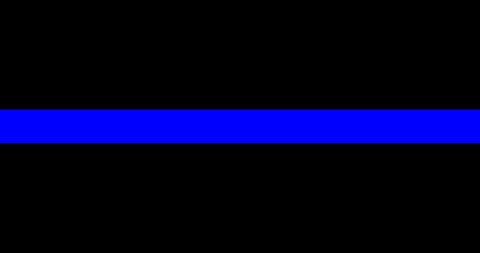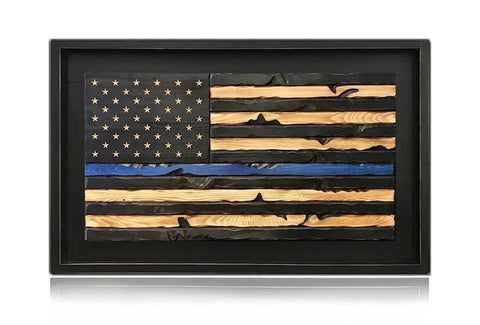

Joyce Comments: Just an observation and a constructive suggestion. It seems like all this kneeling to the U.S. flag started around the time dress codes and personal etiquette loosened up on our traditionally clean-shaven, bare-fleshed police officers and they began to resemble the very gang-bangers they were arresting. Also, the thin blue line flag used in the United States when a police officer was killed was originally all black with the blue line - now seen is version of a distorted stars and stripes behind it. My suggestion, since law enforcement is not exclusive to the United States as most civilized countries also have them to maintain order - is to PERMANENTLY RETIRE THE THIN BLUE LINE OLD GLORY FLAG SYMBOL (seen below) making the black with the horizontal thin blue line the one accepted version. The one with the U.S. stars and stripes seems to possibly cause confusion with the American flag thus disrespectful Tebow-style kneeling, instead of hand on the heart or saluting, occurs.
What is the Thin Blue Line Flag?
Source: https://www.flagsofvalor.com/blogs/news/the-thin-blue-line
...A question we are often asked and worth some explanation. While the roots of the thin blue line trace its origins to the United Kingdom, it has grown in popularity here in the United States as a recognition of the commitment of law enforcement as protectors of our communities.
What is the Thin Blue Line? The phrase is borrowed from a military image of the 19th century, in which a "thin red line" of British troops ("redcoats") held off a Russian cavalry charge during the Crimean war. The first appearance of the Thin Blue Line dates back to the early 1900s when The United States Army marched into battle in their blue uniforms. Together, standing alongside, the soldiers formed a blue line, thus beginning the history we know today as the Thin Blue Line. The phrase "Thin Blue Line" was initially mentioned in a 1911 poem by Nels Dickmann Anderson. In the 1950s, the blue line was adopted by law enforcement professionals to represent their courage and sacrifice while protecting the American people.
The Thin Blue Line emblem was established to symbolize all law enforcement personnel similar to the Red Cross symbol representing all medical personnel. The Thin Blue Line embodies the unbreakable component of law enforcement standing as a safety barrier between the law-abiding citizens of America and the criminally inclined.
Ronald Reagan once said, "Evil is powerless if the good are unafraid."
Above the blue line represents the "good" spoken in Reagan's quote, while below the line represents the "evil." The law enforcement brothers and sisters in the United States make Ronald Reagan's quote a reality, and the Thin Blue Line represents their constant bravery. They risk their lives daily upon the streets of America. The Thin Blue Line is a small token to remind us that the presence of law enforcement is to bring forth peace and diminish hostility and violence.
Just as the American flag pays tribute to the American people and the country's sacrifices to gain independence; the flag containing the Thin Blue Line pays homage to our law enforcement. Displaying the flag in any forum demonstrates support to our law officers for their thankless efforts in keeping the peace across our great nation.
Modern Symbol
The Thin Blue Line flag is a field of black background separated by a thin blue line. The symbolic meaning of this thin blue line is representative of all law enforcement officers. On top you have the law abiding portion of a community + a thin blue line + and all others who would intend chaos and destruction.
The team at Flags of Valor recognizes the incredible demands on law enforcement around our county, nation and beyond. We also share a common sense of fellowship forged in dangerous life and death situations.
The Flags of Valor Thin Blue Line wood flag incorporates the original design expanded onto subdued Old Glory wooden American flags, below.
Honor & Respect
Often times the best way to help yourself is to help others – and for our team of combat veterans creating our Lines Collection and the Thin Blue Line wooden flag in particular is one way we can honor our brothers and sisters in blue.
We welcome the opportunity to recognize the law enforcement community and the services they perform for the common good. Please pay them honor and respect as they serve as the line between order and chaos.
Police ease rules on tattoos, turbans, beards
Source: https://www.foxnews.com/us/police-ease-rules-on-tattoos-turbans-beardsJanuary 29, 2017

In this Tuesday, Jan. 24, 2017 photo, New York City police officer Mandeep Singh speaks during an interview with The Associated Press at the 41st Precinct in the Bronx borough of New York. (AP)
NEW YORK – The Joe Friday look is out. Tattoos, turbans and beards are in.
Police departments, compelled by a hiring crisis and eager for a more diverse applicant pool, are relaxing traditional grooming standards and getting away from rules that used to require a uniformly clean-shaven, 1950s look.
More officers are on the job with tattoos inked on their forearms, beards on their chins or religious head coverings like hijabs and turbans in place of — or tucked beneath — their blue caps.
"My turban is a part of me," said Mandeep Singh, among 160 Sikhs in the New York City Police Department who last month were allowed to wear navy blue turbans in place of the standard-issue police caps. "This opens a gate for other potential candidates who felt they could not be a police officer because they would have to choose either the job or their faith."
That followed a 2014 move by the St. Paul, Minnesota, police to create a special hijab for its first female Somali Muslim officer.
Muslim NYPD officer Masood Syed, who grows a beard for religious reasons, was suspended for its length and sued his department last year over a rule requiring beards to be trimmed to within a millimeter of the skin. As a result, the department changed the length to a half-inch and reinstated him. Syed's suit is still pending, though, because he said the length is arbitrary and it should be case by case, depending on the officer's needs.
"It's 2017," Syed said. "The police department is supposed to reflect the community that it's policing."
Many departments say it's tougher to attract candidates to a physically demanding job that offers low pay and is under increasingly intense public scrutiny. That has led many to make a nod to shifting fashion trends, particularly among millennials, and ease longstanding bans on beards and visible tattoos.
New Orleans; Portland, Oregon; Austin, Texas; and Pinellas Park, Florida, are among the departments that look the other way if a recruit comes in with visible tattoos.
"Modern practice is colliding with dress codes," said Will Aitchison, an attorney who represents police unions during labor-related disputes. "And what police departments really should be focused on is how the officer performs his or her job, as opposed to how they look."
In Kansas, state police did a public survey on whether officers should be allowed to have tattoos to help determine whether to change their policy after they couldn't fill about 100 trooper jobs.
Half of the nearly 20,000 respondents had tattoos themselves. Sixty-nine percent said the department shouldn't have a policy prohibiting visible tattoos.
"We were surprised by the response," said Lt. Adam Winters. "It just doesn't seem to bother people."
Still, the department's prohibition on visible tattoos has stayed in place, in part because of the potential challenge of regulating the content of tattoos that might be offensive.
In Philadelphia, the department is considering tightening its policy after photos surfaced last fall of an officer in uniform with a tattoo on his forearm showing a Nazi symbol: a spread-winged eagle under the word "Fatherland."
In Chicago, a federal judge threw out a lawsuit filed by tattooed officers — all military veterans — who objected to a new requirement that they wear long sleeves to cover up their inked arms during a sweltering Midwestern summer. The judge argued it would be too difficult for departments to determine what would be considered offensive and need to be covered.
But, the police brass recently started allowing them again — they said as a morale booster for a beleaguered force.







































